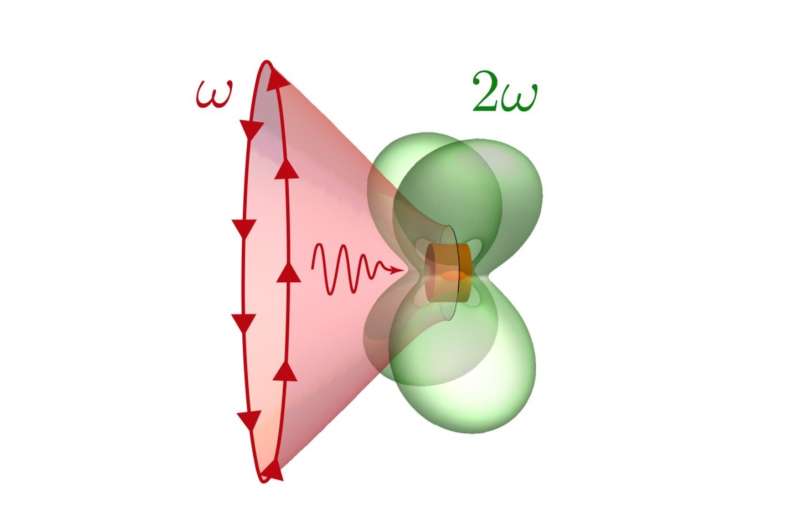Physicists design a nano-resonator with strong nonlinear response

An international research team has found a way to make frequency conversion of light at the nanoscale 100 times more efficient. The new method is based on isolated dielectric nanoparticles supporting so-called bound states in the continuum. Such states appear when radiating fields in the particle suppress each other, so that the electromagnetic energy inside the particle can be trapped. This prediction can be employed for a new generation of tiny frequency conversion devices called nanolasers. The research was published in Physical Review Letters on July 19, 2018.
One of the key problems of nonlinear nanophotonics is the frequency conversion of electromagnetic radiation at the nanoscale. By changing the frequency, the radiation can be converted from one spectral band to another: from terahertz to infrared, and from infrared to visible. This transformation can be carried out effectively by macroscopic devices, but it is a challenge to achieve the frequency conversion at the nanoscale.
The interaction of nanoparticles with light is quite special because of their very small size. Therefore, in order to increase efficiency of the frequency conversion of light at the nanoscale, it is necessary to reduce energy losses during the key processes occurring in the nanoparticle: radiation input, energy confinement, and nonlinear conversion.
To solve all these problems, an international team of physicists from the ITMO University, Nonlinear Physics Centre of the Australian National University, and the University of Brescia in Italy proposed to use new nanoscale resonators. They are, in essence, disk-shaped dielectric nanoparticles with a high refractive index that support the so-called bound states in the continuum. Such states can be created when several types of electromagnetic energy oscillations in the particle mutually suppress each other. In this way, the energy of light can be "locked" inside the particle.
Mathematically, the energy can be locked forever, provided that the resonators are absolutely ideal. In practice, it is possible to trap light for a finite, yet quite long time, even in a single nanoparticle. This requires an optimal ratio of the particle shape, size, and material.
"Although we described such peculiar dielectric nanoresonators previously, we have not yet analysed their practical perspectives. Now, together with our Italian colleagues Dr Luca Carletti and Prof Constantino De Angelis, we calculated how this resonator generates the light with a double frequency. The results show that this structure helps to increase the efficiency of the nonlinear processes by two orders of magnitude. However, this was not that easy, as we had to find the optimal way of pumping the energy into the resonator. We found out that in our case, the incident wave had to be polarized in a way that it oscillates along the tangent to the circle. This coincides with the structure of the electromagnetic field inside the particle," says Kirill Koshelev, a member of the International Metamaterial Laboratory of the ITMO University.
As a result, the research team managed to achieve a record-high efficiency of frequency doubling of light with dielectric nanoparticles. Now, instead of a 100th part of a percent, it is possible to save up to several percent of the light energy during the conversion. This result paves the way to experimental detection of radiation converted by a nanoparticle, which means that the proposed method can be used in practical applications.
"We have suggested a design of nanoscale converters of light that can be used for various applications. For example, they can be used in night vision flat-optics devices which convert infrared radiation into visible light. At the same time, the dielectric material we chose, aluminium-gallium arsenide, has mature fabrication technology. Since the material is widely available, we expect that our idea and predictions will push the further progress in nonlinear nanophotonics and meta-optics," says Professor Yuri Kivshar, co-Chair of the Department of Nanophotonics and Metamaterials of the ITMO University also Distinguished Professor of the Australian National University.
More information: Luca Carletti et al. Giant Nonlinear Response at the Nanoscale Driven by Bound States in the Continuum, Physical Review Letters (2018). DOI: 10.1103/PhysRevLett.121.033903
Journal information: Physical Review Letters
Provided by ITMO University




















